EMD-Based Feature Extraction for Power Quality Disturbance Classification Using Moments
Abstract
:1. Introduction
2. Theoretical Background
2.1. Empirical Mode Decomposition
- For a data set, the number of extrema and the number of zero crossings points must be either equal or differ at most by one.
- The mean value of the envelope defined by the local maxima and the local minima must be zero at any point.
2.2. Shannon Entropy
2.3. Skewness
2.4. Kurtosis
2.5. Artificial Neural Networks
2.6. Proposed Methodology
3. Experimentation
3.1. Computer Simulation of PQD
3.2. EMD Estimation on Voltage/Current Signals
3.3. ANN Training
3.4. Experimental Setup for PQD
4. Results
4.1. ANN Validation Results
4.2. Simulation Results
4.3. Experimental Results
4.4. Discussion
5. Conclusions
Acknowledgments
Author Contributions
Conflicts of Interest
Abbreviations
| A/D | Analog-to-Digital |
| ANN | Artificial Neural Network |
| DAS | Data Acquisition System |
| EMD | Empirical Mode Decomposition |
| FFT | Fast Fourier Transform |
| IMF | Intrinsic Mode Functions |
| MLP | Multi-Layer Perceptron |
| PQ | Power Quality |
| PQD | Power Quality Disturbances |
| pu | Per-Unit |
| SNR | Signal-to-Noise Ration |
| THD | Total Harmonic Distortion |
References
- Chattopadhyay, S.; Mitra, M.; Sengupta, S. Electric Power Quality, 1st ed.; Springer: New York, NY, USA, 2011. [Google Scholar]
- IEEE Std 1159–2009 (Revision of IEEE Std 1159–1995), IEEE Recommended Practice for Monitoring Electric Power Quality; IEEE Power & Energy Society: New York, NY, USA, 2009.
- CEI/IEC 61000–4-30 International Standard. Testing and Measurement Techniques—Power Quality Measurement Methods, 1st ed.; International Electrotechnical Commission: Geneva, Switzerland, 2003.
- Markiewicz, H.; Klajn, A. Standard EN 50160-Voltage Characteristics of Public Distribution Systems, Voltage Disturbances; Copper Development Association: Hemel Hempstead, UK, 2004. [Google Scholar]
- Mahela, O.P.; Shaik, A.G.; Gupta, N. A critical review of detection and classification of power quality events. Renew. Sustain. Energy Rev. 2015, 41, 495–505. [Google Scholar] [CrossRef]
- Ferreira, D.D.; de Seixas, J.M.; Cerqueira, A.S. A method based on independent component analysis for single and multiple power quality disturbance classification. Electr. Power Syst. Res. 2015, 119, 425–431. [Google Scholar] [CrossRef]
- Moreno, R.; Visairo, N.; Nunez, C.; Rodriguez, E. A novel algorithm for voltage transient detection and isolation for power quality monitoring. Electr. Power Syst. Res. 2014, 114, 110–117. [Google Scholar] [CrossRef]
- Dai, Z.; Lin, H.; Yin, H.; Qiu, Y. A novel method for voltage support control under unbalanced grid faults and grid harmonic voltage disturbances. IET Power Electron. 2015, 8, 1377–1385. [Google Scholar] [CrossRef]
- Yılmaz, I.; Durna, E.; Ermis, M. Design and implementation of a hybrid system for the mitigation of PQ problems of medium-frequency induction steel-melting furnaces. IEEE Trans. Ind. Appl. 2016, 52, 2700–2713. [Google Scholar] [CrossRef]
- Yau, H.-T.; Wang, M.-H.; Wang, T.-Y.; Chen, G. Signal clustering of power disturbance by using chaos synchronization. Int. J. Electr. Power Energy Syst. 2015, 64, 112–120. [Google Scholar] [CrossRef]
- Real-Calvo, R.; Moreno-Munoz, A.; Gonzalez-de-la-Rosa, J.J.; Pallares-Lopez, V.; Gonzalez-Redondo, M.J.; Moreno-Garcia, I.M. An embedded system in smart inverters for power quality and safety functionality. Energies 2016, 9, 1–25. [Google Scholar] [CrossRef]
- Ahila, R.; Sadasivam, V.; Manimala, K. An integrated PSO for parameter determination and feature selection of ELM and its application in classification of power system disturbances. Appl. Soft Comput. 2015, 32, 23–37. [Google Scholar] [CrossRef]
- Dehghani, H.; Vahidi, B.; Naghizadeh, R.A.; Hosseinian, S.H. Power quality disturbance classification using a statistical and wavelet-based hidden Markov model with Dempster–Shafer algorithm. Int. J. Electr. Power Energy Syst. 2013, 47, 368–377. [Google Scholar] [CrossRef]
- Kanirajan, P.; Kumar, V.S. Power quality disturbance detection and classification using wavelet and RBFNN. Appl. Soft Comput. 2015, 35, 470–481. [Google Scholar] [CrossRef]
- Biswal, B.; Biswal, M.; Hasan, S.; Dash, P.K. Nonstationary power signal time series data classification using LVQ classifier. Appl. Soft Comput. 2014, 18, 158–166. [Google Scholar] [CrossRef]
- Upadhyaya, S.; Mohanty, S.; Bhende, C.N. Hybrid methods for fast detection and characterization of power quality disturbances. J. Control Autom. Electr. Syst. 2015, 26, 556–566. [Google Scholar] [CrossRef]
- Deokar, S.A.; Waghmar, L.M. Integrated DWT–FFT approach for detection and classification of power quality disturbances. Int. J. Electr. Power Energy Syst. 2014, 61, 594–605. [Google Scholar] [CrossRef]
- Zafar, T.; Morsi, W.G. Power quality and the un-decimated wavelet transform: An analytic approach for time-varying disturbances. Electr. Power Syst. Res. 2013, 96, 201–210. [Google Scholar] [CrossRef]
- Krishnanand, K.R.; Dash, P.K.; Naeem, M.H. Detection, classification, and location of faults in power transmission lines. Int. J. Electr. Power Energy Syst. 2015, 67, 75–86. [Google Scholar] [CrossRef]
- De Yong, D.; Bhowmik, S.; Magnago, F. An effective power quality classifier using wavelet transform and support vector machines. Expert Syst. Appl. 2015, 42, 6075–6081. [Google Scholar] [CrossRef]
- Huang, N.; Zhang, S.; Cai, G.; Xu, D. Power quality disturbance recognition based on multiresolution generalizaed S-transform and a PSO-improved decision tree. Energies 2015, 8, 549–572. [Google Scholar] [CrossRef]
- Abdelsalam, A.A.; Eldesouky, A.A.; Sallam, A.A. Classification of power system disturbances using linear Kalman filter and fuzzy-expert system. Int. J. Electr. Power Energy Syst. 2012, 43, 688–695. [Google Scholar] [CrossRef]
- Shi, S.; Gao, L.; Ma, L.; Chen, Z.; Zhang, Y. Research on flicker measurement algorithm based on FFT. Energy Procedia 2012, 14, 1709–1716. [Google Scholar] [CrossRef]
- Ingale, R. Harmonic analysis using FFT and STFT. Int. J. Signal Process. Image Process. Pattern Recogn. 2014, 7, 345–362. [Google Scholar] [CrossRef]
- Gonzalez-de-la-Rosa, J.J.; Sierra-Fernandez, J.M.; Palomares-Salas, J.C.; Aguera-Perez, A.; Jimenez-Montero, A. An application of spectral kurtosis to separate hybrid power quality events. Energies 2015, 8, 9777–9793. [Google Scholar] [CrossRef]
- Latran, M.B.; Teke, A. A novel wavelet transform based voltage sag/swell detection algorithm. Int. J. Elec. Power. 2015, 71, 131–139. [Google Scholar] [CrossRef]
- Arias, S.; Ustariz, A.J.; Cano, E.A. Detection of power quality disturbances using deformation tensor parameters. IEEE Lat. Am. Trans. 2015, 13, 2106–2113. [Google Scholar] [CrossRef]
- Hajian, M.; Foroud, A.A. A new hybrid pattern recognition scheme for automatic discrimination of power quality disturbances. Measurement 2014, 51, 265–280. [Google Scholar] [CrossRef]
- Kapoor, R.; Gupta, R. Classification of power quality disturbances using non-linear dimension reduction. Electr. Eng. 2013, 95, 147–156. [Google Scholar] [CrossRef]
- Bai, J.; Gu, W.; Yuam, X.; Li, Q.; Xue, F.; Wang, X. Power quality prediction, early warning, and control for points of common coupling with wind farms. Energies 2015, 8, 9365–9382. [Google Scholar] [CrossRef]
- Huang, N.E.; Shen, Z.; Long, S.R.; Wu, M.C.; Shih, H.H.; Zheng, Q.; Yen, N.C.; Tung, C.C.; Liu, H.H. The empirical mode decomposition and the Hilbert spectrum for nonlinear and non-stationary time series analysis. R. Soc. Lond. Proc. Ser. A 1998, 454, 903–995. [Google Scholar] [CrossRef]
- Khokhar, S.; Zin, A.A.B.M.; Mokhtar, A.S.B.; Pesaran, M. A comprehensive overview on signal processing and artificial intelligence techniques applications in classification of power quality disturbances. Renew. Sustain. Energy Rev. 2015, 51, 1650–1663. [Google Scholar] [CrossRef]
- Khatri, M. Power quality event detection, monitoring and improvement: A survey. Int. J. Technol. Enhance. Emerg. Eng. Res. 2015, 3, 67–73. [Google Scholar]
- Perveen, R.; Kishor, N.; Mohanty, S.R. Fault detection for offshore wind farm connected to onshore grid via voltage source converter-high voltage direct current. IET Gener. Transm. Dis. 2015, 9, 2544–2554. [Google Scholar] [CrossRef]
- Ramesh-Babu, N.; Jagan-Mohan, B. Fault classification in power systems using EMD and SVM. Ain Shams Eng. J. 2016, PP, 1–9. [Google Scholar] [CrossRef]
- Vergura, S.; Zivieri, R.; Carpentieri, M. Indices to study the electrical power signals in active and passive distribution lines: A combined analysis with empirical mode decomposition. Energies 2016, 9, 211. [Google Scholar] [CrossRef]
- Shukla, S.; Mishra, S.; Singh, B. Power quality event classification under noisy conditions using EMD-based de-noising techniques. IEEE Trans. Ind. Infrom. 2014, 10, 1044–1054. [Google Scholar] [CrossRef]
- Mahela, O.P.; Shaik, A.G. Topological aspects of power quality improvement techniques: A comprehensive overview. Renew. Sustain. Energy Rev. 2016, 58, 1129–1142. [Google Scholar] [CrossRef]
- Eristi, H.; Ucar, A.; Demir, Y. Wavelet-based feature extraction and selection for classification of power system disturbances using support vector machines. Electr. Power Syst. Res. 2010, 80, 743–752. [Google Scholar] [CrossRef]
- Decanini, J.G.M.S.; Tonelli-Neto, M.S.; Malange, C.V.; Minussi, C.R. Detection and classification of voltage disturbances using a Fuzzy-ARTMAP-wavelet network. Electr. Power Syst. Res. 2011, 81, 2057–2065. [Google Scholar] [CrossRef]
- Manimala, K.; Selvi, K.; Ahila, R. Optimization techniques for improving power quality data mining using wavelet packet based support vector machine. Neurocomputing 2012, 77, 36–47. [Google Scholar] [CrossRef]
- Shannon, C.E. A mathematical theory of communication. Bell Syst. Tech. J. 1948, 27, 379–423. [Google Scholar] [CrossRef]
- Hernandez-Vargas, M.; Cabal-Yepez, E.; Garcia-Perez, A. Real-time SVD-based detection of multiple combined faults in induction motors. Comput. Electr. Eng. 2014, 40, 2193–2203. [Google Scholar] [CrossRef]
- Deperlioglu, O.; Kose, U. An educational tool for artificial neural networks. Comput. Electr. Eng. 2011, 37, 392–402. [Google Scholar] [CrossRef]
- Khokhar, S.; Mohd Zin, A.A.; Mokhtar, A.S.; Ismail, N. MATLAB/Simulink based modeling and simulation of power quality disturbances. In Proceedings of the 2014 IEEE Conference on Energy Conversion (CENCON), Johor Bahru, Malaysia, 13–14 October 2014; pp. 445–450.
- Hooshmand, R.; Enshaee, A. Detection and classification of single and combined power quality disturbances using fuzzy systems oriented by particle swarm optimization algorithm. Electr. Pow. Syst. Res. 2010, 80, 1552–1561. [Google Scholar] [CrossRef]
- Bollen, M.H.J.; Gu, I.Y.H. Characterization of voltage variations in the very-short time-scale. IEEE Trans. Power Deliv. 2005, 20, 1198–1199. [Google Scholar] [CrossRef]
- Bollen, M.H.J. What is power quality? Electr. Power Syst. Res. 2003, 66, 5–14. [Google Scholar] [CrossRef]
- Bollen, M.H.J. Understanding Power Quality Problems: Voltage Sags and Interruptions, 1st ed.; Wiley-IEEE Press: Piscataway, NJ, USA, 1999. [Google Scholar]
- Programmable AC Power Source—Model. 61700 Series; Chroma ATE Inc.: Taoyuan County, Taiwan, 2000; Available online: http://www.chromausa.com/document-library/user-manuals-61700/ (accessed on 19 January 2016).
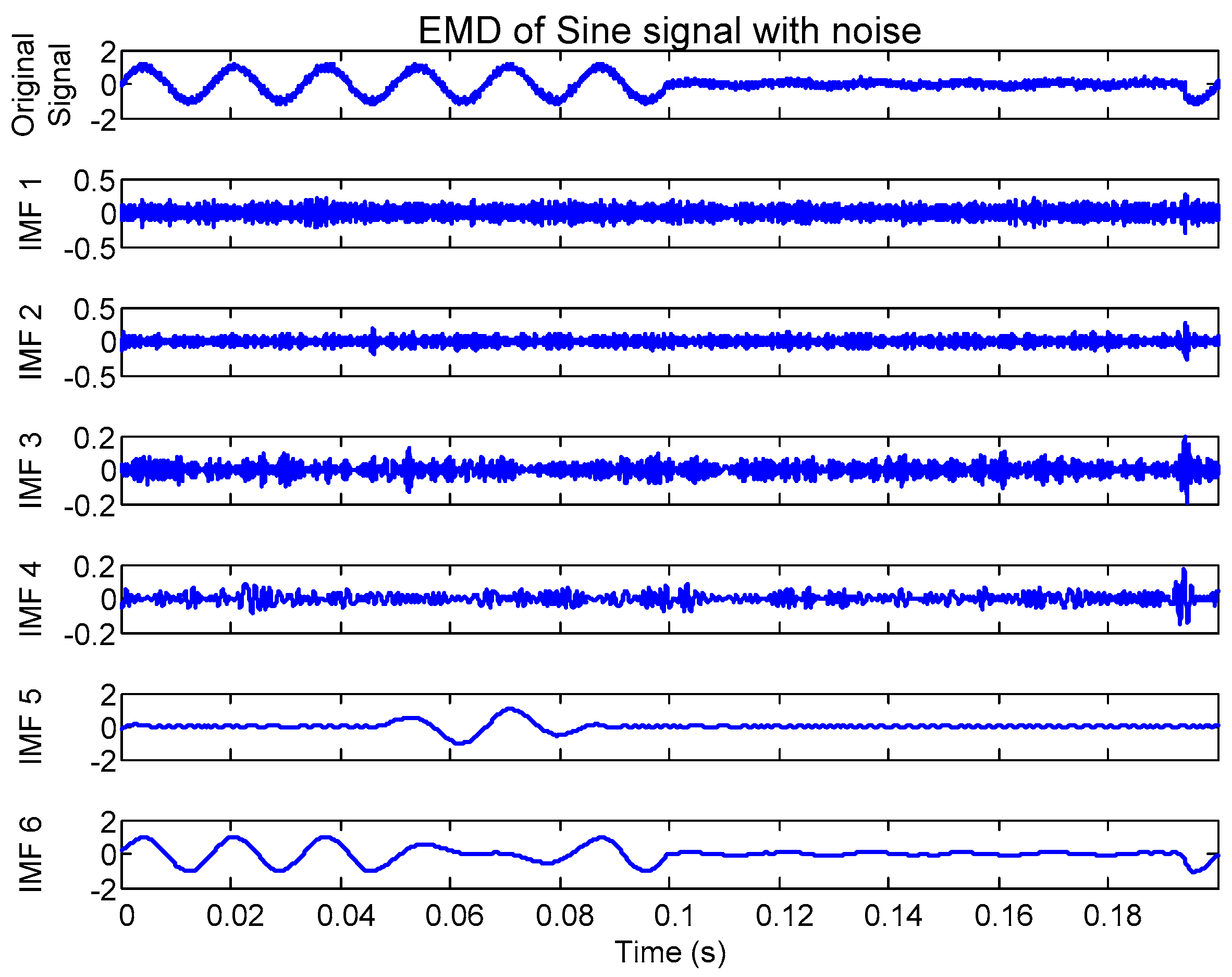
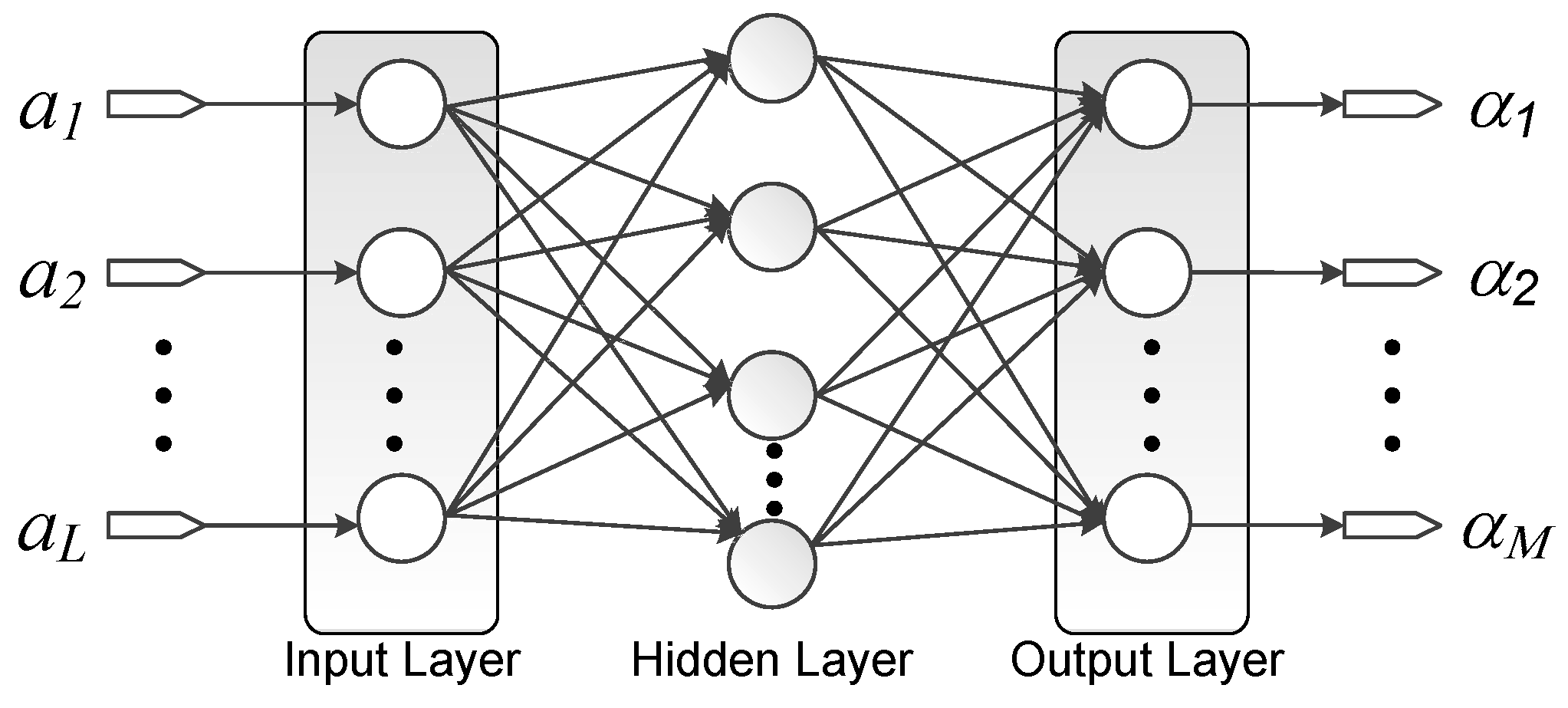
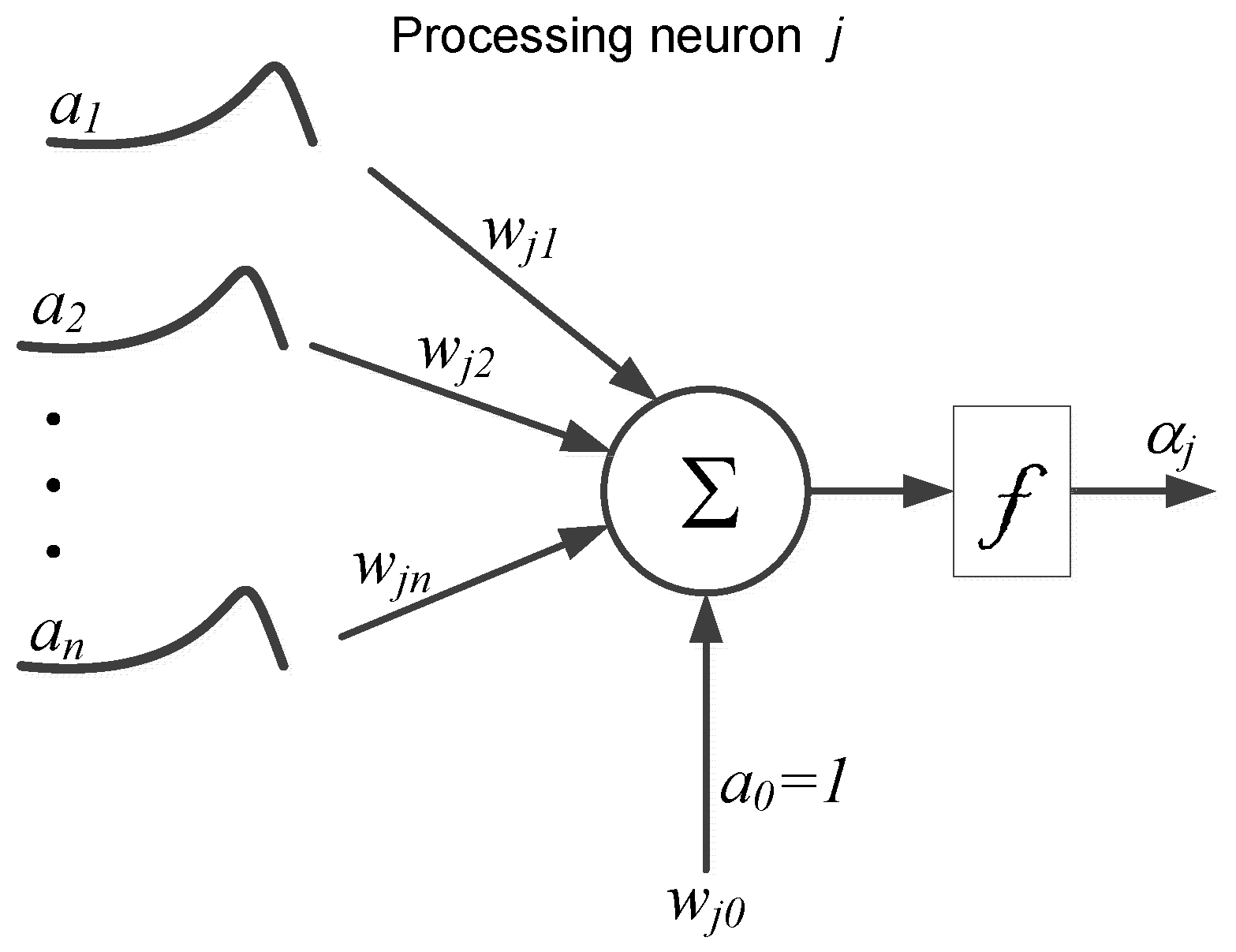

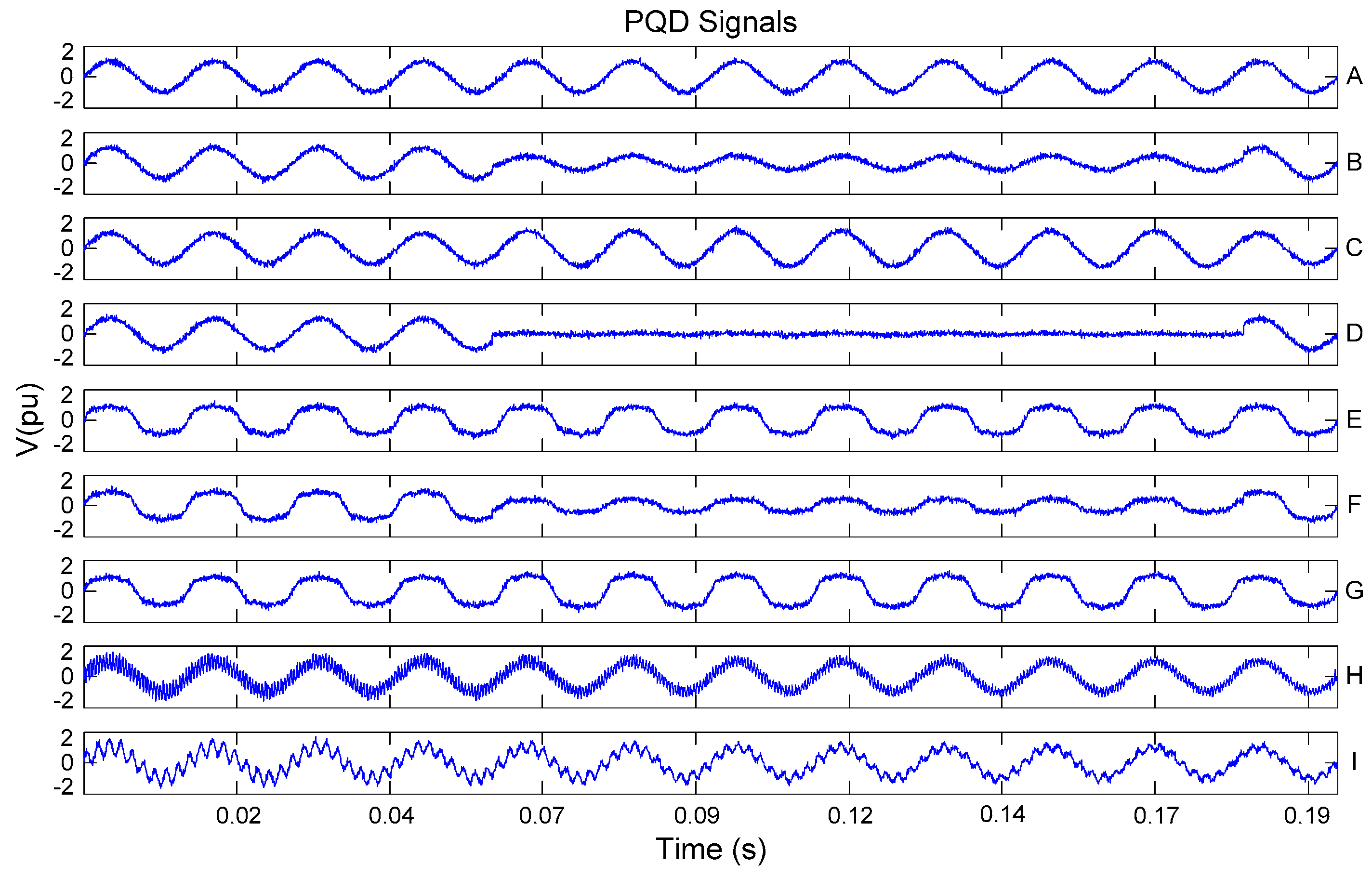

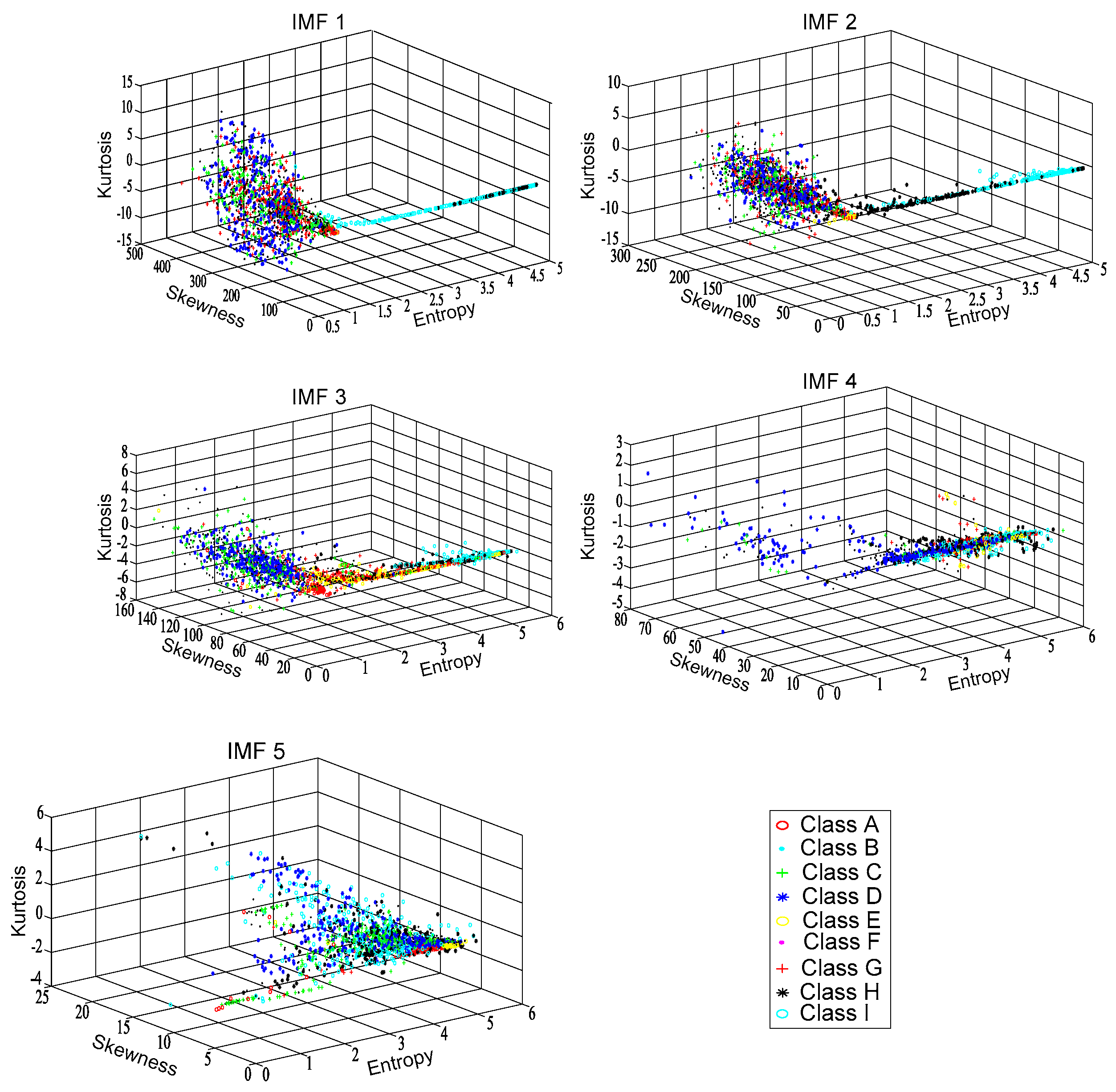
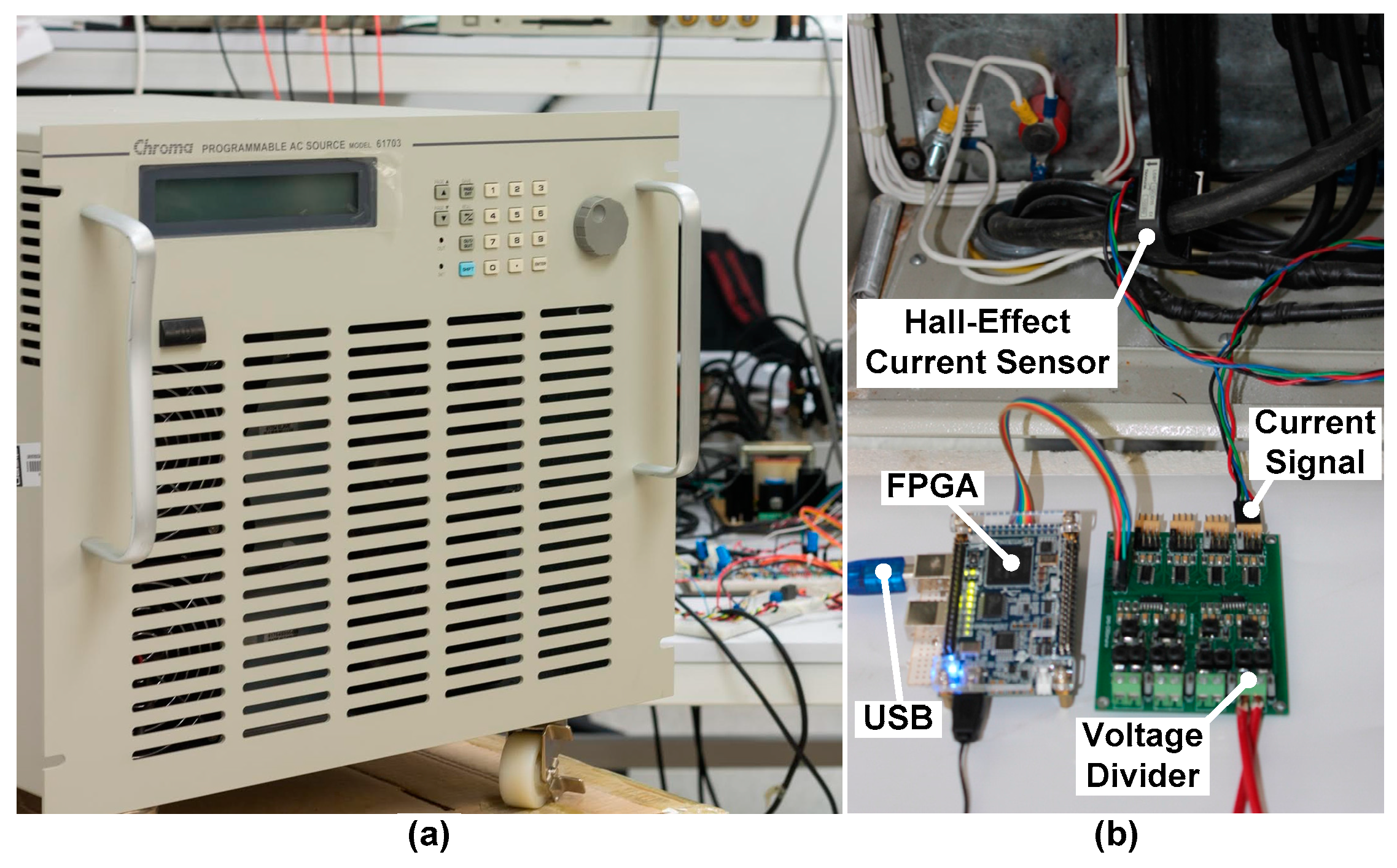

| References | PQD | Model T ≤ t2 − t1 ≤ 9 | Parameters | Class |
|---|---|---|---|---|
| [17,39,40,41,45,46] | Pure Sine | – | A | |
| [17,39,40,41,45,46] | Sag | 0.1 ≤ α ≤ 0.9 | B | |
| [17,39,40,41,45,46] | Swell | 0.1 ≤ α ≤ 0.8. | C | |
| [17],[39,40,41]*,[45,46] | Outage | 0.9 ≤ α ≤ 1 | D | |
| [17],[39,40,41]*,[45,46] | Harmonic | 0.1 ≤ α3 ≤ 0.2 0.05 ≤ α5 ≤ 0.1 0.1 ≤ α ≤ 0.9 | E | |
| [28,39,40,41,46] | Harmonic sag | F | ||
| [28,39,40,41,46] | Harmonic swell | 0.1 ≤ α3 ≤ 0.2 0.05 ≤ α5 ≤ 0.1 0.1 ≤ α ≤ 0.8 | G | |
| [17,28,39,40,41,46] | High frequency transient | 20 ≤ b ≤ 80 0.1 ≤ λ ≤ 0.2 0.1 ≤ α ≤ 0.9 | H | |
| [17,28,39,40,41,46] | Low frequency transient | 5 ≤ b ≤ 20 0.1 ≤ λ ≤ 0.2 0.1 ≤ α ≤ 0.9 | I |
| Class | A | B | C | D | E | F | G | H | I |
|---|---|---|---|---|---|---|---|---|---|
| THD min | 0.18 | 3.59 | 2.92 | 15.91 | 12.09 | 12.66 | 12.38 | 2.64 | 4.70 |
| THD max | 5.59 | 6.66 | 5.97 | 21.13 | 21.74 | 21.96 | 21.96 | 6.46 | 11.53 |
| Architecture | |
| Number of layers | 3 |
| Number of Neurons in the layers | Input = 15, hidden = 28, output = 9 |
| Initial weights and biases | Random |
| Activation function | Sigmoid |
| Training | |
| Learning rule | Levenberg-Marquardt back-propagation |
| Mean-square error | 1 × 10−8 |
| Class | A | B | C | D | E | F | G | H | I | Accuracy % |
|---|---|---|---|---|---|---|---|---|---|---|
| A | 300 | 0 | 0 | 0 | 0 | 0 | 0 | 0 | 0 | 100 |
| B | 0 | 300 | 0 | 0 | 0 | 0 | 0 | 0 | 0 | 100 |
| C | 0 | 0 | 300 | 0 | 0 | 0 | 0 | 0 | 0 | 100 |
| D | 0 | 0 | 0 | 300 | 0 | 0 | 0 | 0 | 0 | 100 |
| E | 0 | 0 | 0 | 0 | 300 | 0 | 0 | 0 | 0 | 100 |
| F | 0 | 0 | 0 | 0 | 0 | 300 | 0 | 0 | 0 | 100 |
| G | 0 | 0 | 0 | 0 | 0 | 0 | 300 | 0 | 0 | 100 |
| H | 0 | 0 | 0 | 0 | 0 | 0 | 0 | 300 | 0 | 100 |
| I | 0 | 0 | 0 | 0 | 0 | 0 | 0 | 0 | 300 | 100 |
| Overall success rate | – | 100 | ||||||||
| Class | 20 dB | 30 dB | 40 dB | 50 dB |
|---|---|---|---|---|
| A | 100 | 100 | 100 | 100 |
| B | 99.33 | 99.66 | 100 | 100 |
| C | 97 | 99.66 | 100 | 100 |
| D | 100 | 95.66 | 99 | 99.66 |
| E | 100 | 98 | 99.66 | 100 |
| F | 100 | 95 | 97.33 | 100 |
| G | 98.66 | 100 | 97.33 | 99.66 |
| H | 100 | 100 | 99.66 | 100 |
| I | 100 | 100 | 100 | 99.33 |
| Overall | 99.44 | 98.66 | 99.22 | 99.85 |
| Class | A | B | C | D | E | F | G | H | I |
|---|---|---|---|---|---|---|---|---|---|
| Effectiveness | 100% | 100% | 100% | 100% | 100% | 100% | 100% | 100% | 100% |
| Class | A | B | C | D | E | F | G | H | I | Overall | |
|---|---|---|---|---|---|---|---|---|---|---|---|
| [17] DWT-FFT | 100 | 98.2 | 95.6 | 100 | 98.1 | 98.2 | 98.6 | ---- | 98.4 | 98.4 | |
| [28] DWT-Hyperbolic S-Transform | ---- | ---- | ---- | ---- | ---- | ---- | ---- | ---- | ---- | 99.2 | |
| [39] Wavelet-SVM | 100 | 92.5 | 100 | 99 | 98.5 | 97 | 98 | ---- | ---- | 97.9 | |
| [40] Fuzzy-ARTMAP -wavelet | ---- | 98.5 | 100 | 100 | 99.7 | 99.2 | 100 | ---- | ---- | 99.6 | |
| [41] WPT-SVM | ---- | 96.7 | 100 | 93.3 | 100 | 96.7 | 100 | ---- | ---- | 97.8 | |
| Proposed | Simulation | 100 | 99.3 | 97 | 100 | 100 | 100 | 98.7 | 100 | 100 | 99.4 |
| Method | Experimental | 100 | 100 | 100 | 100 | 100 | 100 | 100 | 100 | 100 | 100 |
© 2016 by the authors; licensee MDPI, Basel, Switzerland. This article is an open access article distributed under the terms and conditions of the Creative Commons Attribution (CC-BY) license (http://creativecommons.org/licenses/by/4.0/).
Share and Cite
Lopez-Ramirez, M.; Ledesma-Carrillo, L.; Cabal-Yepez, E.; Rodriguez-Donate, C.; Miranda-Vidales, H.; Garcia-Perez, A. EMD-Based Feature Extraction for Power Quality Disturbance Classification Using Moments. Energies 2016, 9, 565. https://doi.org/10.3390/en9070565
Lopez-Ramirez M, Ledesma-Carrillo L, Cabal-Yepez E, Rodriguez-Donate C, Miranda-Vidales H, Garcia-Perez A. EMD-Based Feature Extraction for Power Quality Disturbance Classification Using Moments. Energies. 2016; 9(7):565. https://doi.org/10.3390/en9070565
Chicago/Turabian StyleLopez-Ramirez, Misael, Luis Ledesma-Carrillo, Eduardo Cabal-Yepez, Carlos Rodriguez-Donate, Homero Miranda-Vidales, and Arturo Garcia-Perez. 2016. "EMD-Based Feature Extraction for Power Quality Disturbance Classification Using Moments" Energies 9, no. 7: 565. https://doi.org/10.3390/en9070565
APA StyleLopez-Ramirez, M., Ledesma-Carrillo, L., Cabal-Yepez, E., Rodriguez-Donate, C., Miranda-Vidales, H., & Garcia-Perez, A. (2016). EMD-Based Feature Extraction for Power Quality Disturbance Classification Using Moments. Energies, 9(7), 565. https://doi.org/10.3390/en9070565








